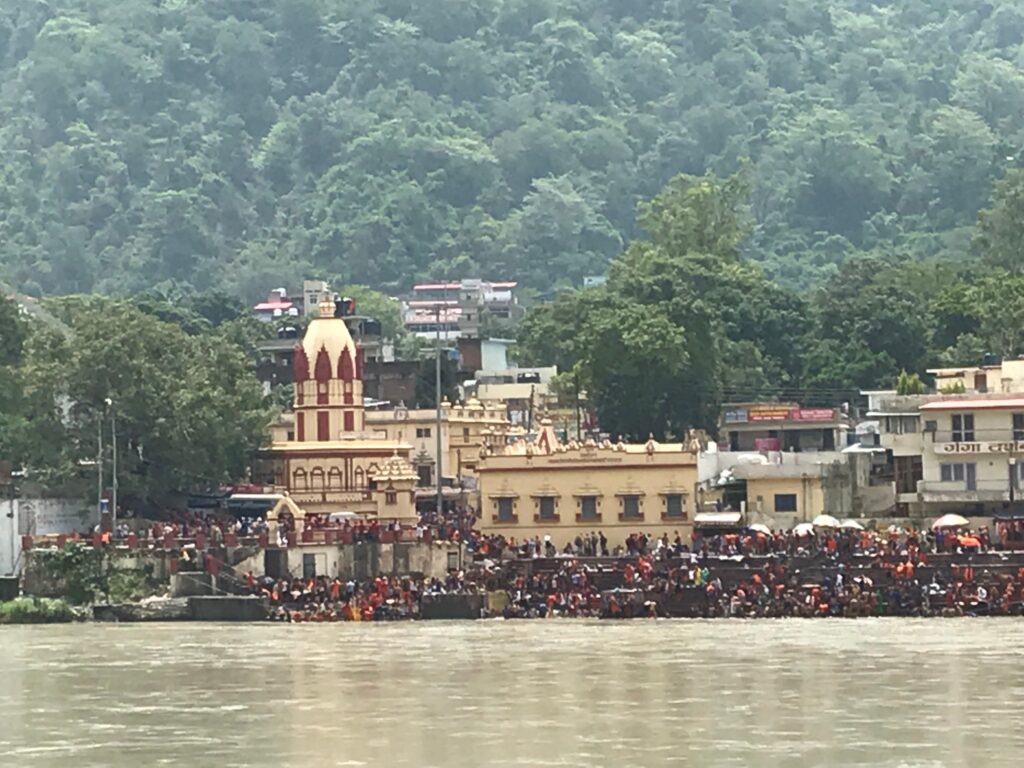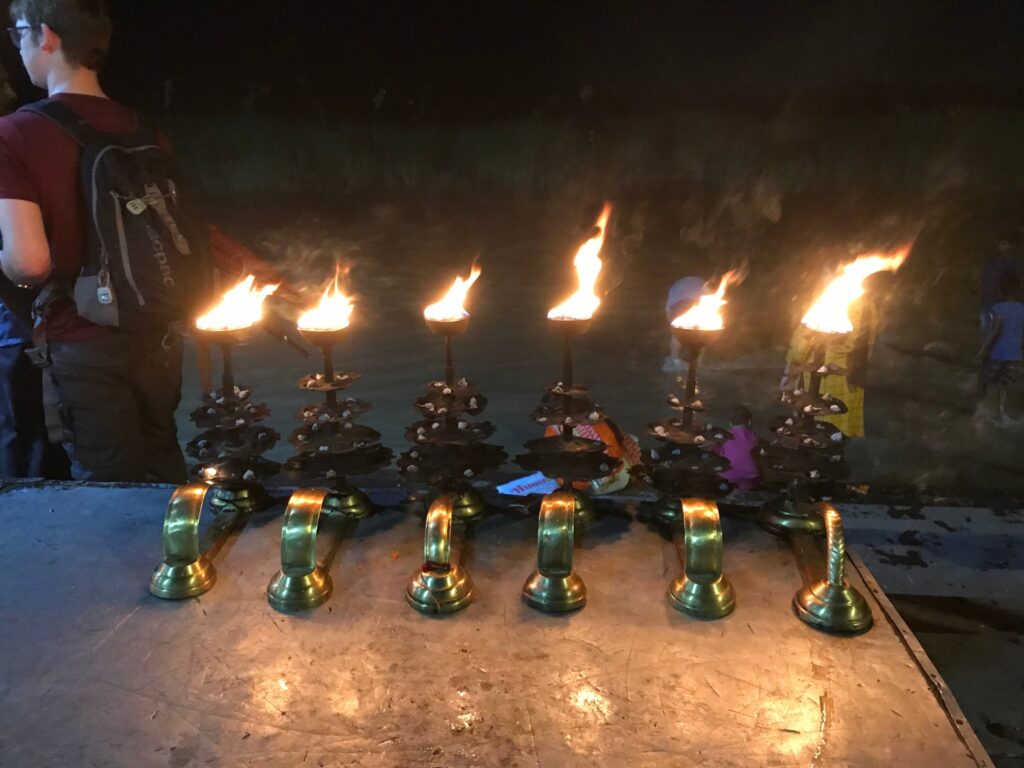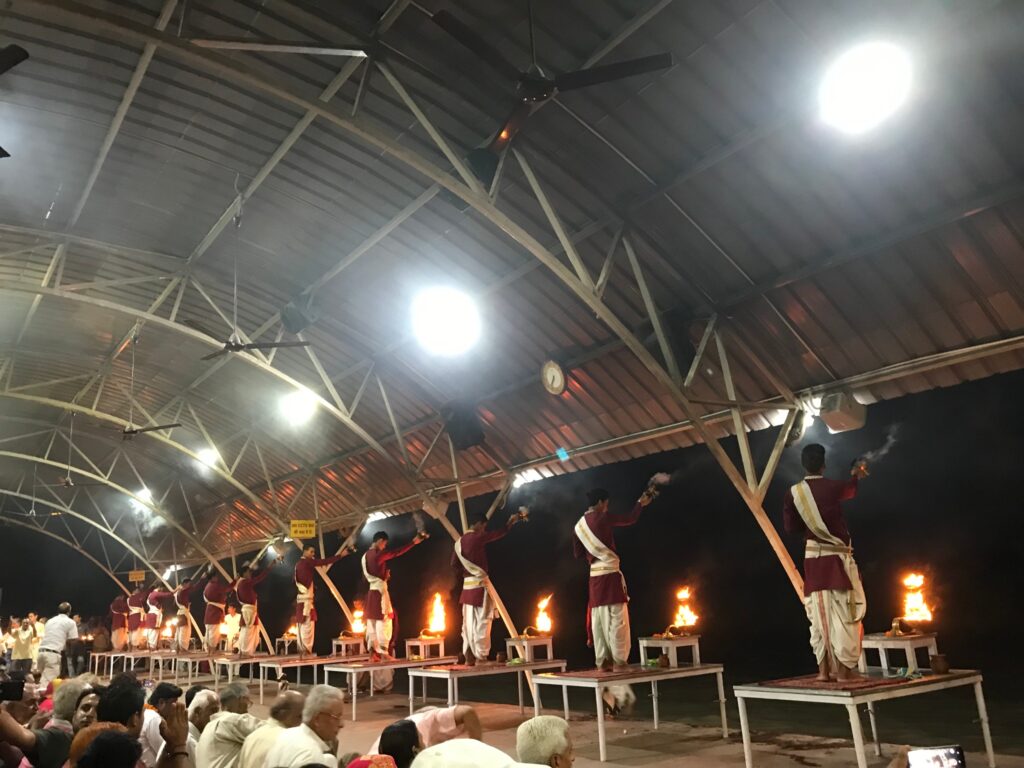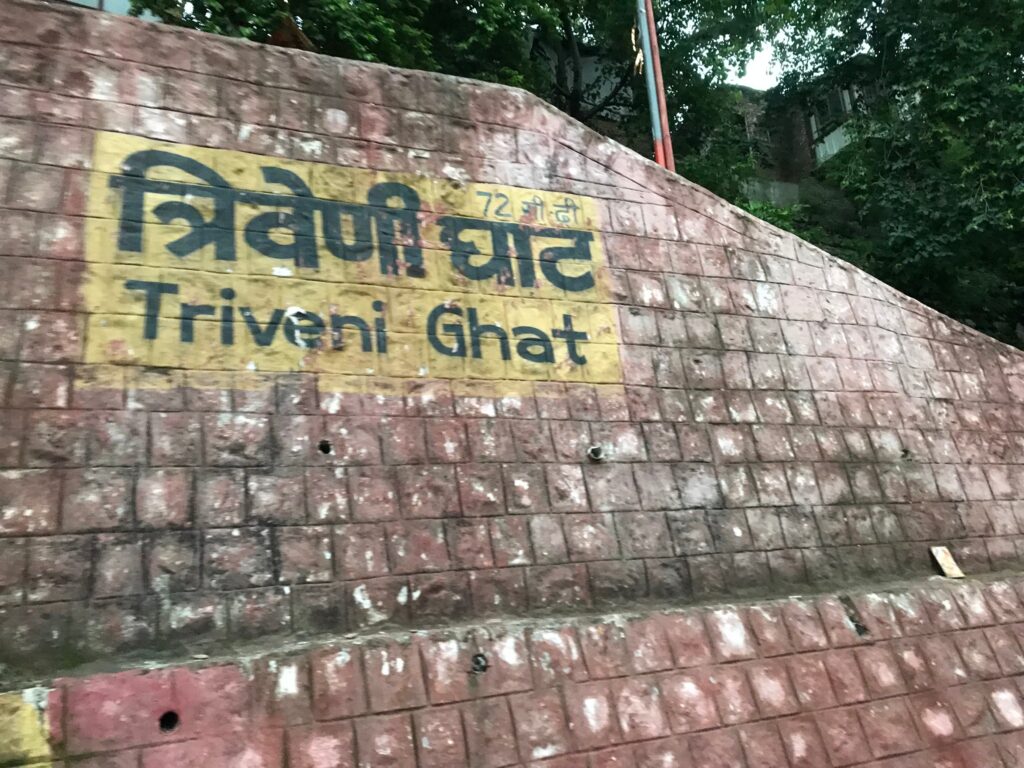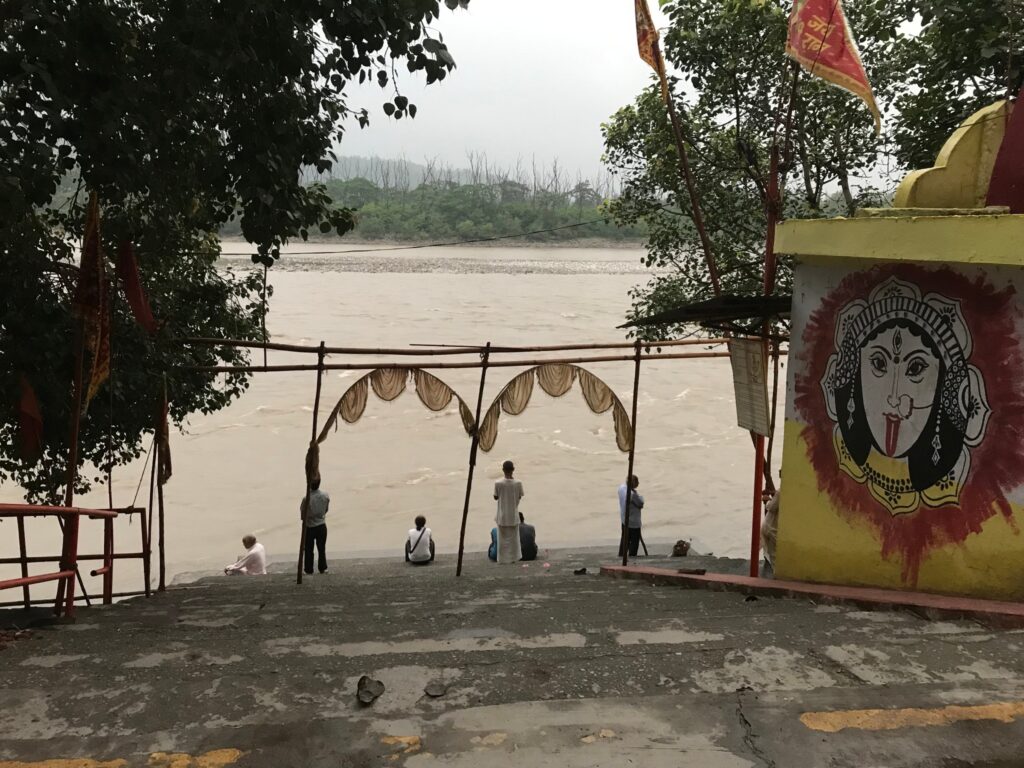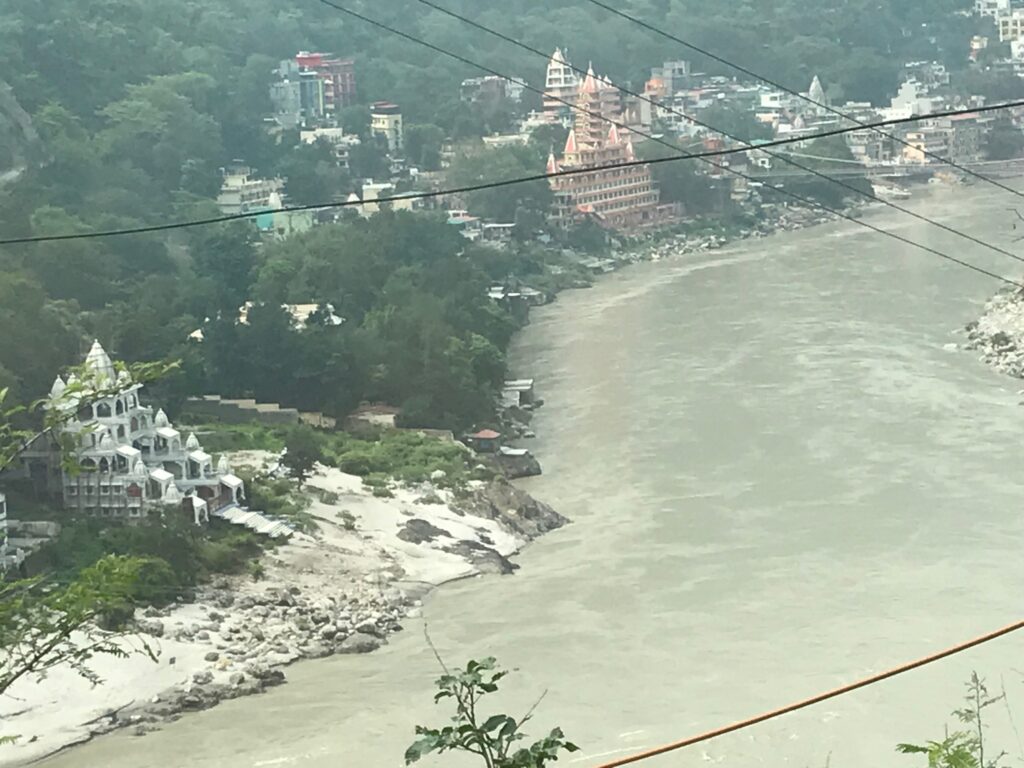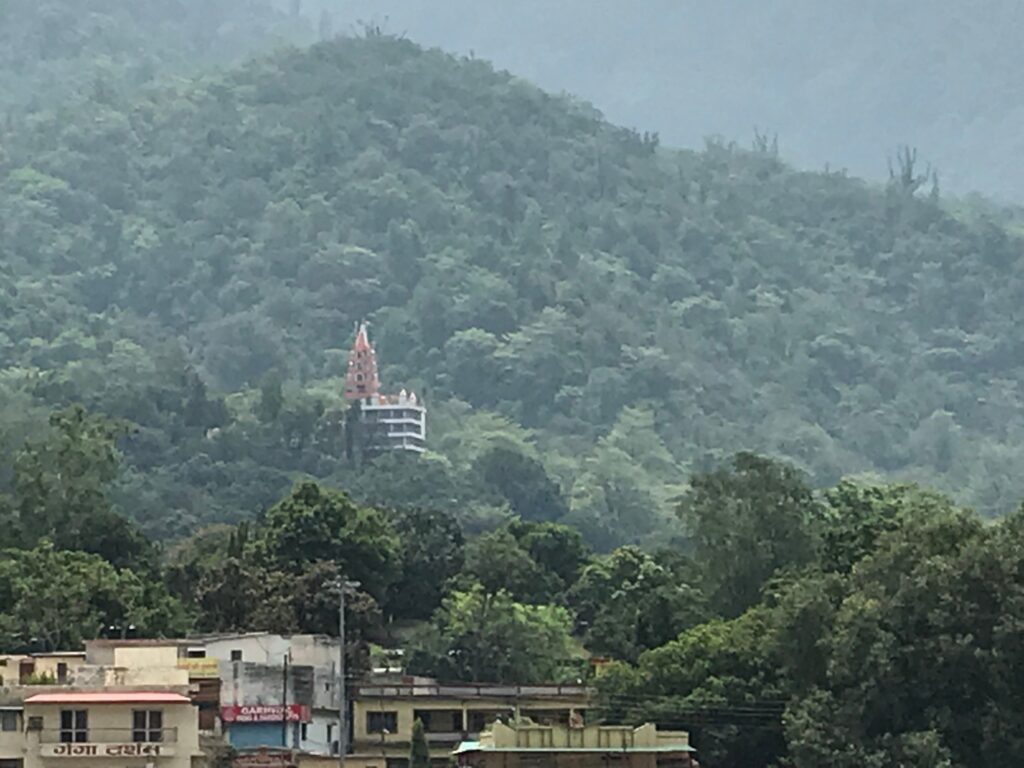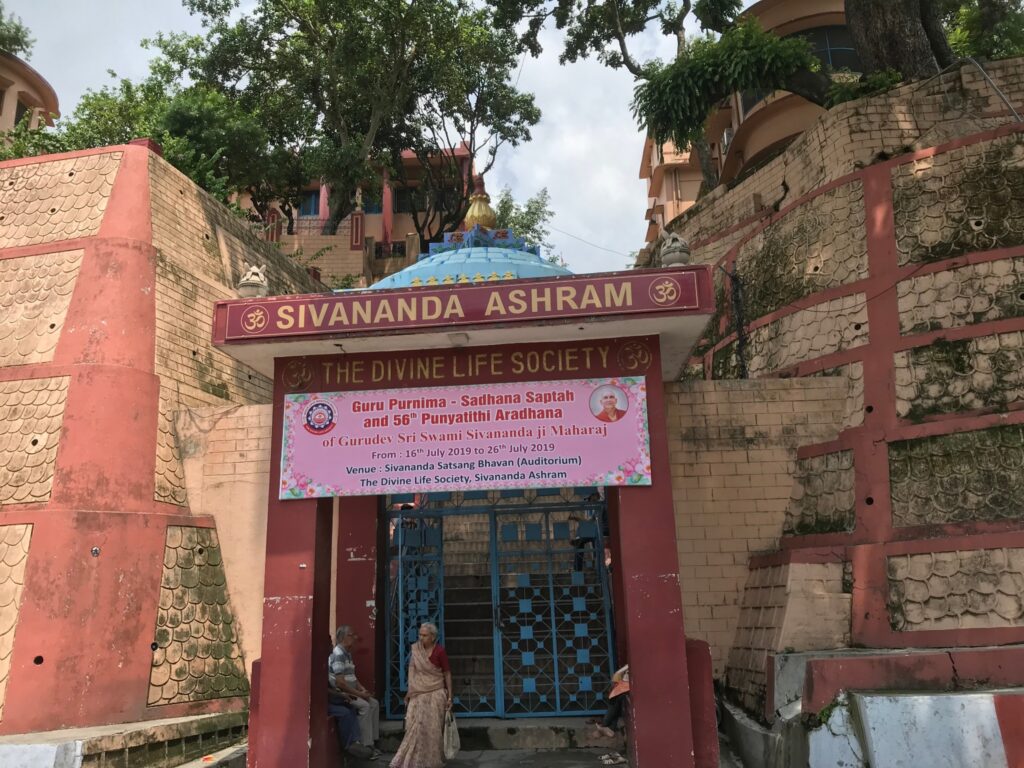| Char Dham Yatra – Rishikesh- Days 1 to 4 |
Char Dham Yatra – Pilgrimage to the Himalayas – Days 1 to 4
Om Namah Shivaya. I am very happy that we all as a group have got this opportunity to listen to the narration of the Chaar Dhaam Yatra – a journey to the four holy abodes. Our nation Bharat is full of supernatural powers and religious places; where the bliss of worship with lamps and a holy flame can be seen flowing through every street, every nook & corner and every grain or particle. From amongst all these, I shall describe to you all, the bliss and glory of the four sacred abodes nestled in the Himalayas. I along with all of you and you all along with me, together we will partake of the bliss of this narrative. I will tell you about some of the important places forming a part of this yatra pilgrimage. It is my wish that you all enjoy thoroughly, the bliss of this sacred journey. This pilgrimage will be completed in about 15-20 days. I shall write just a little about each place, everyday, so that your patience and joy remain intact. As we journey along, please feel free to ask any questions that you may have pertaining to this pilgrimage, without any hesitation whatsoever. Come on then, let us embark now on this spiritual trip.
Hail Bhole Baba – Lord Shiva!
Hail Jagadambe Mata – Universal Mother!
Day One – Rishikesh
The word Rishikesh is a combination of two words: Rishik & Esh. Rishik means Indriyas – the sense organs and Esh means Lord or Master. Rishikesh is that place where, having gained control over the mind and the senses, one can utilise its ethereal, supernatural energy to awaken or activate the power of one’s inner meditative state. Rishikesh was also the dwelling place of a very famous saint – Rishi Rihana. He performed a lot of penance here on the banks of Mother Ganga. Pleased by his penance, Lord Vishnu manifested before Rihana Rishi as Rishikesh, to reward him. This place acquired the name Rishikesh because of this. Rishikesh is located in the district of Dehra Dun which falls within the state of Uttarakhand, in India. Rishikesh is a sublime place situated at the foothills of the Garhwal Himalayan range. Nestled in the beautiful and captivating Shivalik range of mountains, Rishikesh is an enchanting place surrounded by scenic nature and the Himalayan mountains. Mother Ganga flowing from this spiritual abode makes Rishikesh an incredible and incomparable destination. The mere sight of Mother Ganga banishes any negative thoughts & feelings lurking within. The power of purity emanating from Mother Ganga renders every mind too clean and pure. Washing away everyone’s sins, the Mother purifies anyone and everyone who go upto her and touch her, making them fresh and pure like a small child. Every moment feels like a new life, when one comes in contact with Mother Ganga. The serene atmosphere of Rishikesh is home to many a famous ashrams – spiritual retreats, like the Shivananda Ashram, Parmarth Ashram and Beatles Ashram to name a few.
Shivanand Ashram
Shivananda ashram was established in the year 1932 by Swami Shivanand, who was one of the very distinguished and hallowed spiritual Guru of his times. The ashram is located on the banks of the sacred Ganga. Situated at the foothills of the majestic Himalayas, this temple like ashram promotes the pursuit of spirituality, in this region.
Parmarth Ashram
Parmarth Ashram was established in 1942 by Saint Sukdevanand ji Maharaj (1901 – 1965). In the year1986, Swami Chidanand Saraswati became the Director and Spiritual Head here. Even to this day, the children studying in this ashram perform prayers and rituals on the banks of the holy Ganges every morning and evening. A huge crowd gathers here everyday to view the sacred Aarti (ceremonial worship with fire-lit lamps) performed on the river bank of Mother Ganga. People from all over the world gather here to receive the Blessings of the Mother Ganges.
Beatles Ashram
In the 1960s, the Beatles band came to Rishikesh to study and learn Yoga. Since then, this city has claimed itself to be the Yoga Capital of the world! At a time when the whole world was crazy after the Beatles, India attracted them to itself. It was nothing more than an unknown religious or spiritual center then, where the world renowned Beatles band came to immersed themselves completely into the practice of Transcendental Meditation.
Rishikesh is full of ashrams. Every one of them have their own unique cup of joy and energy to offer. No matter how much one extols the glory and greatness of these places, it is still never enough or complete. Every year, pilgrims throng the ashrams in Rishikesh in huge numbers, to meditate & experience peace of mind. The specialty of this place is that the pilgrimage to the four holy abodes in the Himalayas begins from here, in the month of May every year. Pilgrims undertaking this sacred journey offer their prayers to Mother Ganga over here and commence their pilgrimage. While staying in Rishikesh and enjoying the bliss of the serene atmosphere in the ashrams found here, we can also visit a lot of holy spots or temples and several other beautiful places in and around Rishikesh. A few such special tourist attractions are the Bhootnath Temple, the Vashishta Gufa (cave), Lakshman Jhoola & Ram Jhoola (two swing like bridges across Ganga), the Neelkanth Mahadev Temple to name a few.
Day Two – Rishikesh Darshan
Swarg Ashram
Swargaashram is located on the eastern bank of Ganga, at a distance of about 5 kms from Rishikesh. This ashram was constructed in honor of the revered and popular Hindu Saint Vishuddhananda. He is also famously referred to as Kali Kamli Wale – the Saint with a black blanket. All religious rites and rituals practiced or performed right from birth until death, are organized in this ashram. Travelers can also study ayurveda & yoga in this ashram. This ashram can be accessed through the Ram jhoola hanging bridge built across Ganges. There is a temple, a few caves and a hostel for students, within the ashram premises itself.
Bhootnath Temple
Bhootnath temple is a hindu temple dedicated to Lord Shiva. This temple is located behind the Parmarth Niketan ashram, in the vicinity of Swargaashram. This temple has many floors. The main temple is a small one located on the uppermost level. From the uppermost level you can have a wonderful and captivating view of Rishikesh. Legend has it that Lord Shiva rested here, when He was traveling to get married to His first wife Sati. People do not go here often, as the temple is enclosed on 3 sides by the Rajaji National Park. You can walk about 800 meters from the rear of Parmarth Niketan. It is at a distance of about 600 meters from the parking lot of Swargaashram. From the parking point of Ram Jhoola, this temple must be at a distance of approx. 1.90 kms on foot. You can easily sight this temple from the Swargaashram vicinity, because of the number of floors and its height, which makes it visible from most of the points in that area. If traveling by car, you can use the overbridge near Virbhadra barrage and pass through the jungle, to go to this temple.
Ram Jhoola
Ram Jhoola connects Shivananda Ashram to the Swargaashram & therefore, it is also referred to as Shivananda Jhoola.
Ram Jhoola is the route one has to take, to cross over from one bank of the Ganges to the other in order to go to Swargaashram area. When you are walking on this bridge over the Ganges, you can experience the infusion of a very positive energy begotten from the waves of Mother Ganga’s gentle and cool breeze. Ram Jhoola is strong enough to withstand heavy loads. Two wheelers can often he seen riding over this bridge. Ram jhoola seems or appears as if it were swinging, when people are walking over it. Even as one walks on Ram Jhoola, feeling a bump or jolt every now and then, one can enjoy a panoramic, bird’s eye view of the Ganga flowing beneath. This Jhoola in itself, is a very beautiful sight to behold. It is verily a living symbol of beauty in Rishikesh. Colorful lights adorn this bridge at night, on special occasions. The sound of Omkar emanating from the waves of Mother Ganga together with the beautiful sight of this bridge makes one feel and desire that time itself should come to a standstill, while one remains seated on the river bank to behold & absorb this sublime, heavenly sight!
Lakshman Jhoola
Lakshman jhoola is another bridge which is 5 kms further ahead of Rishikesh. It is very similar in appearance to Ram Jhoola. Both these swinging bridges are very famous, graceful and defining landmarks of Rishikesh. The Lakshman jhoola made of strong iron cables and angles, bound and anchored with a base of sheet metal checker plates, is about 70 feet above the flowing Ganges. Lakshman jhoola which links one bank of the Ganges to the other is a distinctive landmark of Rishikesh. A temple of Lakshman and Raghunath is located close to the Lakshman Jhoola. Lakshman jhoola is a good sightseeing point from where the surrounding beauteous sights and spots can be viewed and enjoyed. Like on the Ram jhoola, the primeval sound of Om emanating from the Ganges flowing beneath can be heard on the Lakshman Jhoola too. During Puranic times, Lord Lakshmana had constructed at this very spot a swinging bridge made of Jute, to cross the Ganges. The Lakshman Jhoola too feels and seems to swing just like the Ram Jhoola, when people walk on it.
Triveni Ghat
Triveni Ghat is the point of confluence of the three holy rivers Ganga, Yamuna and Saraawati. For the devout believers visiting temples in Rishikesh, it is a must to take a holy dip at this confluence, before heading to the temples there. As per popular belief, taking a holy dip at Triveni Ghat liberates people from all their sins. In the evenings, people gather in thousands to witness the holy ritual of lamps being waved in the air to perform Aarti at this confluence. By way of an offering, pilgrims float cups or bowls (Donas – stitched together using leaves) containing flowers and small lamps, in the holy waters. Rites and rituals praying for peace and fulfillment of the departed souls are also performed on this ghat.
Sathya Sai Ghat
The place near Lakshman Jhoola is called as Tapovan. There is a Sathya Sai School too operating over there. In 2016, the Bhagawan Sri Sathya Sai Ghat was established on the banks of the Ganges. Swami’s bhajans are sung every morning and evening along with the Aarti to Mother Ganga, on this ghat. The Sathya Sai Ghat is also very close to Lakshman Jhoola. Sitting here, you can experience Swami’s Love and feel the sanctifying Love energy of Sai Ganga as it flows by.
Day Three – Rishikesh Darshan
21st June is observed as International Yoga Day. In Rishikesh, this day is celebrated like a huge festival. People go to the banks of Mother Ganga and listening to the sound of Onkar emanating from its flowing waves, they lose themselves in Dhyana Yoga (meditation), infusing themselves with a positive energy. People from all ove the world come to Rishikesh to learn Yoga. It is a physical, mental and spiritual practice of life that we can engage in anywhere and at any time.
Yoga
Yoga is present in our daily activities. It was started by our ancient Gurus in India during the Puranic age, in order to lead a disciplined life.
Rishikesh situated in Uttarakhand is known as the hub or center of Yoga where people from distant lands come to learn Yogasanas. I will now tell you about some exclusive Yoga retreats in Rishikesh where one can be initiated into any form of Yoga.
Parmarth Niketan
If you desire spiritual upliftment along with Yoga then you must go to this ashram established on the banks of the Ganges where, along with some very specialized or exclusive forms of Yoga, you can also enjoy a spiritual lifestyle. This ashram also organizes an International Yoga festival in March every year.
Shivanand Niketan
Shivanand ashram was established by Swami Shivanand. This ashram and Yoga Center is one amongst the leading Yoga Centers of India. This Yoga Center is operated by the Divine Life Society. The knowledge and training imparted here is based on the 5 principles of Yoga:
Asana – Posture
Shwas – Breath control
Vishram – Quiescence
Dhyana – Meditation
Aahaar – Diet control
Tourists can avail of Yoga training free of charge here. This ashram is located close to Ram Jhoola. If you wish to undergo Yoga training in this ashram, you have to put in an application a month in advance.
Shri Mahesh Heritage Meditation School
If you wish to learn Yoga then Mahesh Heritage Meditation School is a good option to consider. This school has a syllabus that imparts a course of learning and training in meditation, for a total of 300 hours. In the initial phase, people who wish to learn Yoga are taught to meditate. The school’s vision and approach is based on Vedic scriptures and you can also engage in the study of Yoga, Ayurveda, Life treatments, Spiritual growth & progress. Besides this, an exclusive non-residential program or course focused on diet and exercise to form healthy habits, make healthy choices and live a healthy lifestyle, is also available from this school.
Yog Niketan
Yog Niketan was established by a famous exponent of Raj Yoga – Swami Yogeshwaranand Paramahans. It is situated in the Muni-ke-Reti area of Rishikesh. A 15 days’ stay is mandatory for undertaking any course in this ashram.
Swami Dayanand Ashram
Swami Dayanand Saraswati established this ashram. This ashram is set amidst very beautiful surroundings, with a panoramic vista. Tourists can learn Yoga sadhana here. A lot of stress is laid upon the Bhagavad Gita here and some of the important Upanishads are also taught here as a part of the syllabus. This ashram is at a distance of 10 minutes on foot, from Ram Jhoola.
Himalayan Yoga Ashram
Himalayan Yoga Ashram is a short distance which teaches the practice of Himalayan Yoga founded in the Vedic tradition, is a short distance from Anand Prakash Hill. Here, the program is a combination of Yoga postures, breath control, meditation and spiritual discourses. Different kinds of ayurvedic treatment practices are also taught here.
Phool Chhatti (Umbrella of Flowers)
The Phool Chhatti ashram is located in the garden of flowers, at a distance of 5 kms from Lakshman Jhoola. This ashram was established towards the end of the year 1800. This ashram is known for its ‘seven-days-of-the-week’ Yoga and meditation programs. Students are imparted courses and training in meditation, breath control, repetitive prayer chanting, observing complete silence, rituals & worship, group chanting and singing of the Lord’s name and various other important facets of the Yoga path.
Similarly, you will come across many other such small or large ashrams and smaller centers where the Yog Guru knowledge and training can be obtained. This town, settled and inhabited on the banks of the serenely flowing Mother Ganga, is ethereal and sublime. The basis of its power is Mother Ganga herself, where saints and sages have performed intense penance for years together and thus attained liberation. Nowadays, this place has become more of an adventure & entertainment destination rather than a spiritual one, for the modern day youth. Mother Ganga welcomes every being who comes to her, purifying them with her Love. This place is truly a symbol and form of a supernatural power. One cannot tell how many temples or ashrams can be found here. Their presence indicates and reiterates the Truth that Rishikesh is one place where, by putting in necessary efforts, a human being can realise oneself; by descending into the depths of his or her life to know the truth, a human being can find and attain oneself. Yoga, Meditation and Spiritual practices – these three can be accessed and imbibed here, at one single place all together. This is the greatness of Rishikesh. No matter how much I write about Rishikesh, the narration will be never ending!
River Ganga – Rishikesh
As such, there are several large and expansive rivers in India, whose cool & flowing waters we can experience, enjoy and hear, while boating upon them. Mother Ganga is considered the foremost amongst India’s holy rivers. Performing prayers to the Ganges and taking a dip in its holy waters in Rishikesh has its own specific importance & significance. Ganga is considered as the bestower of liberation; whose mere touch can grant us the experience of change or transformation within. Therefore, make it a point to bathe in the Ganges because that experience cannot be obtained or found anywhere else in the world. In the evenings, flowers, lamps and incense sticks are floated onto the Ganges and this sight is absolutely enchanting to behold!
These offerings can be accessed very easily even as you are seated on the river bank, because small children will run up to you with these offerings contained in bowls sewn out of leaves. This is a very beautiful moment to experience, followed by the Aarti during which these offerings are floated onto the holy waters. The spectacle of thousands of these floating bowls of lamps is a sight to behold during the twilight hours, giving one a feeling as if the skies along with thousands of stars have descended upon the holy waters. This experience is a very fulfilling and satisfying one. With its clear waters and favourable currents, the Ganges is also considered the leading and best suited river for rafting, in India.
I myself too have experienced the joy of river rafting and boating on the Ganges. Needless to say, it was a very beautiful and memorable experience. When you board your boat and sail on this ancient river, you tend to get carried away, captivated by its pristine beauty. Besides experiencing the thrill of an adventurous sport like rafting, one can also unwind and de-stress while engaging in some aspects of this courageous activity. The 4 prominent river rafting points here are Shivpuri – 16 km from Rishikesh, Marine Drive – 24 km from Rishikesh, Brahmapuri – 9 km from Rishikesh and Kaudiyala – 36 kms from Rishikesh. In river rafting, the level of difficulty ranges from basic to challenging and it all depends upon what level you opt for.
Mother Ganga’s Love is incomparable; She is that Mother who bestows upon her children both these experiences – Spiritual and Adventurous!
Day 4 – Rishikesh Darshan
There is a very good market area to visit, browse through and shop from. There are markets near both Ram Jhoola and Lakshman Jhoola where one can easily find essentials and other items for one’s home, and also for performing any religious ceremonies, rituals, prayers etc. Worship materials such as Rudraksh, sandalwood powder & paste, garlands, religious books, pictures of Gods, yoga mats etc., can be easily obtained here. Geeta Bhavan is quite a large shop where you get all kinds of religious books. When in Rishikesh, we must set aside an entire day for shopping too! This by itself is a very interesting experience over there. The banks of Ganga are dotted with such small and big shops. There is an all day boat service too for ferrying people from one bank of the Ganges to the other. One can, while traveling in these boats, touch and feel the cool waters of Mother Ganga. That again is a blissful moment to experience.
Let us move forward now …
Neelkanth Mahadev Rishikesh
Neelkanth Mahadev Temple is at a height of approximately 5500 feet from Rishikesh, located at the peak of the mountain rising above Swarg Ashram. From Muni-ki-Reti, Neelkanth Mahadev temple is 50 kms by road and 25 kms when crossing the Ganga by boat. Neelkanth Mahadev Temple is a prime tourist attraction of the holy town of Rishikesh nestled at the bottom of the Himalayan mountains. Neelkanth Mahadev is amongst the most venerable temples in Rishikesh. Lord Shiva drank the poison churned out from the ocean, at this very spot. At that very moment, Maa Parvati constricted Lord Shiva’s throat by pressing it, because of which the poison did not flow further down to His stomach. Thus, the poison remained in the region of His throat and His throat turned blue because if it. It is for this reason that Lord Shiva is also extolled as Neelkanth. Hence, this exceptionally powerful temple is dedicated to Lord Shiva. There is a spring of water within the temple premises where devotees take a bath before proceeding to have Darshan of Lord Shiva. This temple’s outstanding carving and engraving work is to be seen to be believed. On the roof of the temple is an attractive painting of ‘Samudra Manthan’ – the churning of the Ocean and inside the sanctum sanctorum is a very amazing painting of Lord Shiva intaking the deadly poison. The south Indian vastu based sculpture and architecture is very obvious in this temple. Along with the Shivling within the temple premises, an interminable (Akhand) fire too is present which from time immemorial has been a witness to the penance performed there by countless Saints, Sages and Siddhas (Enlightened Masters). The presence of a very ancient, old and large Banyan tree, again stands testimony to the timelessness of this place. Those with belief tie a thread symbolising their prayer or desire, which they come back to untie once their wish is granted. Opposite to the Sanctum Sanctorum, on a hill is a temple of Mother Parvati. This Holy place also provides a wonderful view of the Vishnukoot, Brahmakoot and Manikoot mountains. The confluence of the rivers Madhumati or Manibhadra and Pankaja or Chandrabhadra at the base of these three mountains is the reason for the coolness in the atmosphere of this region. Neelkanth Mahadev temple is quite crowded with the devout and the faithful, during the Shivratri festival and in the monsoon season. It is said that for those devotees who for some reason are unable to visit Kedarnath or Badrinath, it is a must that they at least visit Neelkanth Mahadev temple to have Lord Neelkanth’s darshan and perform Abhishek – anoint and consecrate the Shivling with holy water and other sacred offerings. That prosperity and fame which can be gained by having the Darshan of Badrinath and Kedarnath, can be gained by going only to the Neelkanth Mahadev temple. Much like how Bholenath ji drank the deadly poison, He will snatch away the troubles and problems of the devotees praying to Him in this temple. That is how Bholenath is; the One who is very easily pleased with everyone of His devotees. No matter how much I go on describing the glory of Neelkanth Mahadev, it is inexhaustible. Therefore, repeat: Neelkanth Mahadev Ki Jai!
Rishikesh is a land of saints and sages. Historically, many saints have meditated here and attained liberation. As much deeper you delve into the history and glory of this place, that many more mysteries and secrets will be discovered by you. It is a sacred place where the Lord Himself has descended to play so many Leelas – games and wrought so many miracles. Let us now move ahead towards another similar and ethereal destination. It is a place with a sacred cave, where we can really lose ourselves in meditation. Yes, the place is Vashisht Gufa. Come, let us get to know the history behind this cave. Let us find out the mystery under lying this sacred cave situated along the banks of the Ganges.
Vashisht Gufa
Vashisht Gufa is named after a great Sage Vashishta who performed intense penance in this cave to find and reach Lord Shiva. Pleased with his penance, Lord Shiva granted him Darshan – a vision of Himself and asked him what he desired. Sage Vashisht replied, “O Lord! Having had your vision at this place, I pray that you station Yourself here.” In reply, Lord Shiva told Sage Vashisht that He cannot do so because if He were to limit Himself in that small cave, then who would take of His entire creation? Instead, Lord Shiva granted Sage Vashisht a boon, ordaining that this cave would become renowned all over the world by Sage Vashiaht’s name and people from the far corners of the world would come there for Lord Shiva’s Darshan. Lord Shiva granted another boon to Sage Vashisht, blessing that any individuals who are troubled or beset with any problems or are in a predicament where there is no end to their worries, will be rid of all their troubles and anxieties as soon as they enter this cave. They will experience only me and my powers when inside this cave. So saying, Lord Shiva disappeared and Sage Vashisht continued his penance & meditation until he breathed his last in this cave. This cave is 16 kms further ahead of Rishikesh, located on the banks of the Ganges. If we are returning from Neelkanth Mahadev temple then we can cross the Ganges on boat and travel to this cave from the main road at the other bank. Upon reaching the particular point, this cave can be accessed through the main entrance on the side of the main road. You have to park your cars at this point and descend towards the river bank for about 15 minutes to see this cave. This cave is open in the morning and in the evening. When it is open you can go inside and sit in meditation. This cave is a very prominent place for Dhyana or meditation, situated amidst Goolar Fig trees. Installed inside the cave is a resplendent, beautiful and ethereal Shivling, sitting in front of which you can feel the supernatural power of this cave. Peace within and the primeval sound of the Ganges flowing outside; the combination of these two grants one the ultimate bliss & ecstasy. You must remain as silent and peaceful as possible, when inside the cave and fully absorb the joy of that tranquility within. The renowned Hindu Saint Shri Swami Purushottamanand had come to this place in 1928 and 1961. His ashram located close to this cave is visited by many tourists. No matter how warm or hot it maybe outside, the inside of the cave remains cool always. So, whenever you go to Rishikesh, make sure you go to Vashisht Gufa.
(To be continued …)
